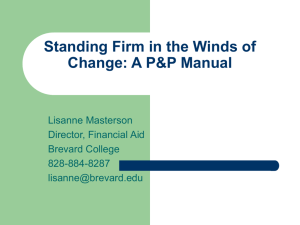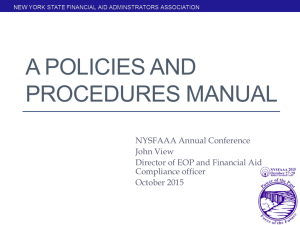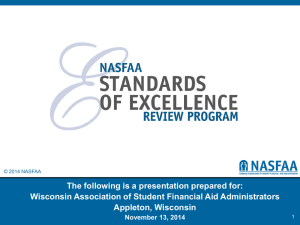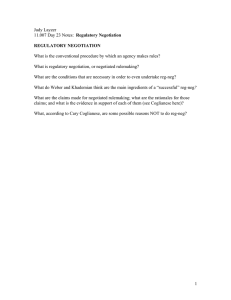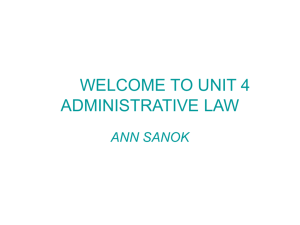Comments from the National Association of Student Financial Aid Administrators (NASFAA)
advertisement
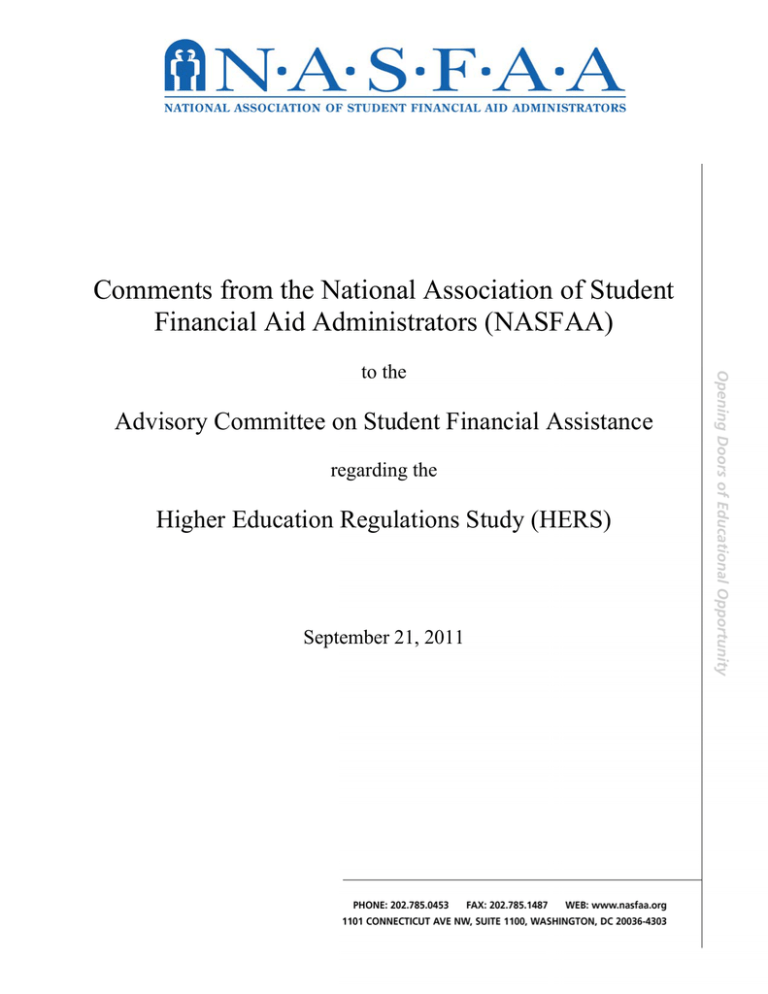
Comments from the National Association of Student Financial Aid Administrators (NASFAA) to the Advisory Committee on Student Financial Assistance regarding the Higher Education Regulations Study (HERS) September 21, 2011 NASFAA September 21, 2011 Comments to the Advisory Committee on Student Financial Assistance Regarding the Higher Education Regulations Study NASFAA commends the Advisory Committee for soliciting comment regarding higher education regulations from practicing financial aid administrators through the Higher Education Regulations Study (HERS). The fact that the topic of burdensome regulations has been a recurring issue over many years is indicative of the detrimental nature of burden, the frequency with which it occurs, and the frustrating difficulty in alleviating it once it has taken hold. In addition to HERS, current efforts include an Executive Order from the Obama Administration directing federal agencies to conduct a retrospective review of federal regulations. NASFAA believes that any solution lies in a two-pronged approach: (1) identify and revise existing regulations that are more burdensome than beneficial, and (2) improve the method by which regulations are formulated. It is our hope that the Advisory Committee’s work will give focus to all the efforts that have occurred or are occurring, and provide a forum for open discussion involving both the financial aid community and the Department of Education. Ideally we would like to see the forthcoming report regarded as a first step in devising a framework for ongoing evaluations of both existing regulation and the efficacy of any proposed new regulation. Identifying specific regulations that unnecessarily drain away resources is certainly a desired outcome, but characterizing the nature and cause of burdensome regulations is equally important. Such an analysis is crucial to preventing future unnecessary burden to both the administrators and recipients of student financial assistance. We have previously submitted comments and testimony to the Advisory Committee regarding areas of burden in the regulations. We wish to focus these comments on the need for better formulation of regulations. There is a recognition that public participation in the rulemaking process is valuable and necessary. We believe that negotiated rulemaking is, when properly practiced, one of the most effective methods for achieving reasonable regulations with public input. However, negotiating committees have often been overwhelmed by too many significant issues to discuss effectively and resolve within the allotted time frame. Issues that were not afforded thorough discussion because of time constraints should not be considered to have been properly negotiated. The negotiating committee also becomes unwieldy in size because it must incorporate all affected parties for diverse issues. Further, bundling disparate issues into one regulatory package 2 NASFAA September 21, 2011 for purposes of consensus too often endangers good work spent achieving agreement on individual issues. We encourage the Advisory Committee to open a dialogue with the financial aid community to find ways of improving both the method of promulgating regulations and public participation in the rulemaking process. We hope that the Advisory Committee does not stop at identifying burdensome regulations. Modeling effective rules is just as important an outcome. Identifying the traits of successful regulation that takes into account institutional variation would contribute to future improvements and reduce overly prescriptive tendencies. For example, NASFAA has long supported an approach to rulemaking that outlines objectives and establishes a framework for institutionallyspecified policies and procedures. Finding a balance between clear, sufficient direction and overly complicated prescription is not easy, but should be one goal of any regulatory review process. NASFAA believes that any discussion of regulatory reform also entails an examination of the program review process, to ensure that it is geared more towards helping schools overcome misunderstanding or inadvertent error than assessing fines and liabilities. Identifying and characterizing poorly constructed regulation can contribute significantly to that goal. Thank you for your efforts in this endeavor. If you have any questions, please contact Megan McClean at mccleanm@nasfaa.org, or on 202.785.6942. Attachment: NASFAA response to the Department of Education’s preliminary plan for retrospective review of regulations 3 July 25, 2011 Docket ID ED–2011–OGC–0004 NASFAA Response to Preliminary Plan for Retrospective Regulatory Review In the July 6, 2011, Federal Register Notice requesting comment on its preliminary plan for regulatory review, the Department of Education (ED) summarizes the principles on which its plan is based, in accordance with Executive Order (EO) 13563. EO 13563 mandates that the federal regulatory system must: allow for public participation and an open exchange of ideas ensure that regulations are accessible, consistent, written in plain language, and easy to understand promote predictability and reduce uncertainty identify and use the best, most innovative, and least burdensome tools for achieving regulatory ends take into account benefits and costs, both quantitative and qualitative measure, and seek to improve, the actual results of regulatory requirements include greater coordination across agencies to reduce redundant, inconsistent, or overlapping requirements. EO 13563 emphasizes public participation in the regulatory process, requiring that: the regulatory process involve public participation comment periods generally be at least 60 days agencies seek the views of those who are likely to be affected by rulemaking prior to issuing Notices of Proposed Rulemaking (NPRMs) ED has identified three guiding principles for use in developing and implementing regulations, guidance, technical assistance, and approaches to compliance that it will incorporate into its retrospective analyses of regulations: 1. Work closely with affected persons and groups. 2. Ensuring regulations are concise and minimize burden to the greatest extent possible while still helping ensure the achievement of program outcomes. 3. Seek greater and more useful public participation in rulemaking activities through the use of transparent and interactive rulemaking procedures and new technologies, in all key stages in the rulemaking process. NASFAA strongly supports the goals described in Executive Order 13563, and agrees with ED’s three guiding principles that reflect those goals. We believe that negotiated NASFAA July 25, 2011 rulemaking is, when effectively practiced, one of the most valuable tools available for achieving these goals and implementing these principles. However, we believe that effective use of negotiated rulemaking necessitates a more substantial commitment of resources than ED has been willing to make in recent regulatory activities. Negotiating committees have too often been overwhelmed by too many significant issues to discuss effectively and resolve within a reasonable time frame. For example, while we commend the Office of Postsecondary Education (OPE) for identifying tough issues that should have benefited from the recent program integrity negotiations, and for approaching negotiations with a desire to achieve consensus, we believe that consensus was doomed from the start by expecting one single negotiating committee to work through 14 issues, almost all of which were complicated and controversial. Some issues received hardly any time for discussion by the final meeting. Further, linking all of those diverse issues into a single consensus requirement in that setting almost guaranteed failure. Failure to achieve consensus results in ED’s ability to bypass any tentative agreements reached on any issue, so that the subsequent NPRM may reflect ED’s views at the expense of other negotiators. ED should incorporate into its regulatory plan every effort to support reasonable expectations and adequate resources for negotiated rulemaking. Using more committees with fewer issues would also eliminate the unwieldiness of large committees that need to incorporate all affected parties for disparate issues. The final retrospective regulatory review plan should include an avenue for corrective action—perhaps even renegotiation—when final rules are not based on a thorough discussion of the issue during negotiated rulemaking. We also believe that a minimum 60-day public comment period once NPRMs are published ought to be strictly observed. To this end, we encourage ED to publish on its Web site any NPRM at the same time that it is conveyed to the Federal Register, rather than maintaining “radio silence” during the time it takes the Federal Register to publish proposed rules. ED has done so sporadically in the past; it should be a regular practice. The preliminary plan put forth for comment by ED covers: existing regulations significant guidance documents (to the extent they are associated with existing regulations) existing information collections (to the extent they are associated with existing regulations) priorities, requirements, definitions, and selection criteria governing discretionary grant programs that are established through rulemaking but are not codified in the Code of Federal Regulations 2 NASFAA July 25, 2011 NASFAA appreciates the difficulty inherent in providing timely guidance while observing the distinction between guidance on existing policy versus formulation of new, significantly extended, or altered policy. The question of formulating regulation with public input, versus issuing subregulatory guidance, has always been a difficult one, especially when aid administrators and higher education associations request the guidance. Safe harbor guidance, especially when new statutes provide inadequate implementation time, is an important tool for both ED and schools. However, the propensity to “codify” guidance into regulation just because it has become established or is long-standing is not justifiable, and tends to preclude consideration of better alternatives. We urge ED to incorporate into its plan for formulation and review of regulations and significant associated guidance, a safeguard against this loss of full public participation in the regulatory process. EO 13563 affirms the principles of Executive Order 12866, including a mandate that, where possible, agencies must: specify performance objectives, rather than specifying the behavior or manner of compliance that regulated entities must adopt identify and assess available alternatives to direct regulation, including economic incentives to encourage desired behavior, such as providing information upon which choices can be made by the public identify and consider regulatory approaches that reduce burdens and maintain flexibility and freedom of choice for the public, including warnings, appropriate default rules, and disclosure requirements as well as provision of clear and intelligible information to the public EO 13563 requires agencies to consider how best to promote retrospective analysis of rules that may be outmoded, ineffective, insufficient, or excessively burdensome, and to modify, streamline, expand, or repeal them in accordance with what has been learned. NASFAA has long supported an approach to rulemaking that outlines objectives and establishes a framework for institutionally-specified procedures. The satisfactory academic progress regulations are a model of such an approach to rulemaking. We encourage ED to incorporate into its review a plan to examine existing regulations with a high degree of specificity for possible reformulation in accordance with this model. We especially recommend that ED review existing regulations to identify instances where the law requires some action or disclosure by schools but does not specifically direct ED to define the procedures by which those actions must be taken, to determine where regulations have become overly prescriptive or excessively burdensome. 3 NASFAA July 25, 2011 According to the Federal Register Notice, in deciding when to regulate, ED considers whether: regulations are essential to promote quality and equality of opportunity in education; a demonstrated problem can be resolved without regulation; regulations are necessary in order to provide a legally binding interpretation that resolves ambiguity; entities or situations subject to regulation are so diverse that a uniform approach through regulation would do more harm than good; and regulations are needed to protect the Federal interest; that is, to ensure that Federal funds are used for their intended purpose and to eliminate fraud, waste, and abuse. In deciding how to regulate, ED states that it will: regulate no more than necessary; minimize burden to the extent possible, and promote multiple approaches to meeting statutory requirements when possible; encourage coordination of federally funded activities with State and local reform activities; ensure that the benefits justify the costs of regulating; to the extent possible, establish performance objectives rather than specify compliance behavior; and encourage flexibility, to the extent possible, so institutional forces and incentives achieve desired results. NASFAA agrees that these considerations are essential. Unfortunately, some burdensome regulations seem to go away only when Congress ends a program or a benefit. We should not cheer the loss of second Pells and ACG/SMART just because the regulations were so burdensome and intensively manual as to make implementation and compliance practically impossible, yet that is what happened. These instances of burdensome regulations were not a result of insufficient public participation, but insufficient attention paid by ED to the results of the negotiated rulemaking process. A withholding of consensus during negotiated rulemaking, especially when concern has been expressed by several negotiators, often is prescient of fundamental problems in implementation of proposed regulations. NASFAA recently conducted a survey of our members regarding burden. Please see the appendix for relevant comments. The recent gainful employment regulations are a good example of “situations subject to regulation [that] are so diverse that a uniform approach through regulation would do more harm than good.” Requiring reporting of data and disclosures when loan debt is so low that the median value is zero seems a waste of institutional resources that could be used far more beneficially to students. The Federal Register Notice mentions that a review of FFELP/DL regulation is currently underway. We agree that is a good example of regulations that are in need of review, 4 NASFAA July 25, 2011 especially in light of repeal of the FFEL program. We hope that ED will consider in that review renewed efforts at cooperation with the Consumer Financial Protection Bureau to address treatment of institutional loans. By and large, ED gets high marks in its efforts to coordinate with other agencies, but this is one area where better coordination would be welcome. ED states in its preliminary plan that it will review the regulations governing the campusbased programs (673, 674, 675, and 676). NASFAA also suggests a careful review of subpart D part 668 together with all other student consumer information-related regulations. ED promises to meet with stakeholders as part of its plan. In the case of student consumer information, we urge ED to involve students in determining the effectiveness of the entire deluge of disclosures that anecdotally cause more confusion than clarity. In addition, a review of 668.22, including a renegotiation of Return of Title IV Funds issues that were shorted in the last round of negotiations due to time limitations, would be helpful. Issues related to nontraditional program formats crop up throughout the regulations and continue to cause difficulty. We recommend that ED undertake a dedicated symposium to understand the issues that schools encounter. However, formulating an agenda is somewhat premature until the review plan is finalized. Rather than include specific regulations up for review, ED’s plan needs to encompass a concerted effort to gather information from schools about other candidates for review. Although public hearings are part of the process, more proactive means of eliciting school input may be necessary. NASFAA would be pleased to assist ED in those efforts. Thank you for this opportunity to comment. Sincerely, Justin Draeger President and CEO 5 NASFAA July 25, 2011 Appendix: Comments Regarding Regulatory Burden from NASFAA 2010 Survey of Membership “The irony of the situation is that as the compliance and paperwork burden increase, institutional budgets for our departments increase and tuition follows that increase. Increased tuition leads to increased need and increased borrowing which leads to increased concerns over outcome and even default rate which leads to more paperwork and more regulations which feeds the cycle.” “The issue that all the various new regs and consequent administrative burdens have taken affect within a very short period of time. I have never seen anything comparable in my 20 years in financial aid.” “The Office is maintaining requirements by working overtime and under a lot of pressure.” “The issue of working extended hours -- overtime. If we didn't put in all the extra hours, our office would collapse. In fact, this is part of our problem. We conceal the need for adequate resources because we do whatever it takes to serve our students.” “Non-aid compliance issues (e.g. fire safety) are being dumped into the laps of financial aid administrators. Formulas and regulations for determining dollar amounts have become too complex and difficult to explain to students. Non-standard term rules are a nightmare to explain to students. Inadequate assistance at the federal level for program, administration, and processing questions.” “Even though we are operating on a greatly reduced budget, we are still able to meet all requirements from DOE, parents, and students. However, we work many evenings and weekends to make sure this happens at no cost to the organization.” “It is difficult to walk the line confirming that we're meeting regulatory requirements when we know the risk we're carrying, what's not getting done, we're constantly bumping against timelines, and everyone's exhausted and losing earned vacation & sick time.” “I can't sum up enough how bombarded our office feels with the 15% sustained enrollment growth, as well as an enormous increase in federal programs and regulations. We just can't keep up for much longer at our current pace. The employees that are here are working so much that there is no time for vacations, personal leave, etc...it is getting out of hand, and the College administration doesn't understand!” 6 NASFAA July 25, 2011 “The biggest problem is the ongoing complexity of the programs we are required to service and the amount of time we have to do it. The transition to Direct Loans is a temporary problem and should be resolved by the end of the academic year both in making sure students complete new MPNs but also with taking on monthly loan reconciliation. But we have more requests to do outreach programs, financial literacy programs, and debt management programs, and our time is stretched between these requests and the need to do more professional judgments, reviewing more student files, and more time counseling families. We have a fantastic staff who are very dedicated and professional and they have spent more over time hours with no compensation and have, at the same time, faced no raises for two years and a cuts in their benefits. I don't think the government can resolve all of these issues but as the economy improves and our college budget adjusts and improves we will see a return of benefits. Luckily, the ACG and SMART program will go away next year and that will help us a little! I always wonder if other government financed programs face the same problems that financial aid administrators do.” “The HEOA/TILA added so many requirements it would be nearly impossible to fulfill all. A program reviewer could find something on any school. To address economy and need for more institutional resources many colleges adding on new programs (like a graduate school adding certificate program or a health professions school adding another discipline). Many times this is done without adding additional staff to financial aid or training for learning UG/GP or HP new area of financial aid. Now with DL only choice we worry about addition of more non-financial aid related requirements to maintain eligibility.” “The regulatory requirements of the programs, especially year-round Pell, are impossible to manage. I know congress meant well when they enacted the requirements, but they ended up just setting up financial aid offices to fail at compliance. The requirements are unmanageable.” “Federal and state regulations regarding financial aid administration have become so complicated that it is extremely difficult to assert 100% compliance. What we most lack is adequate time and resources for staff training and internal compliance review (spot checking, etc.)” “Dept of Ed implementation of Year Round PELL and Gainful employment very cumbersome. Alarmed about trend of Dept of Ed making changes in many areas which are not primary to financial aid but implementing and providing information thru financial aid office rather than to primary function within higher ed. (small example is when was the last time Dept of Ed updated the Blue Book and/or provided training for business 7 NASFAA July 25, 2011 office personnel?) (How many VP's of Instruction are aware that Program Integrity changes effect the definition and calculation of a credit?). Alarmed about the very significant increased use of student loans but Dept of Ed trying to fix by "back door" approach using "gainful employment" rather than addressing fundamental problem that a financial aid office cannot limit use/amount of student loans. I would estimate that our office could predict at least 75% of specific loan students who will ultimately default.” 8
